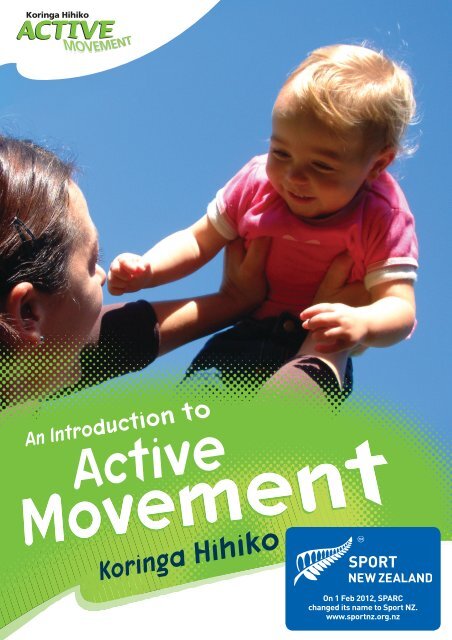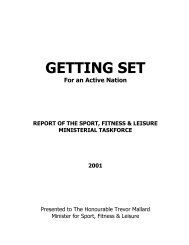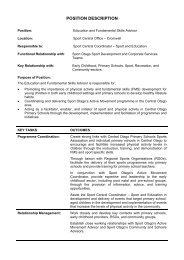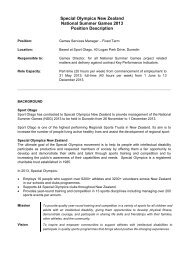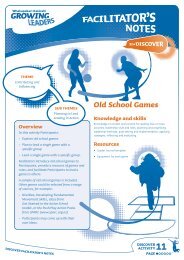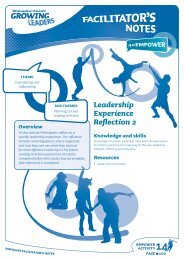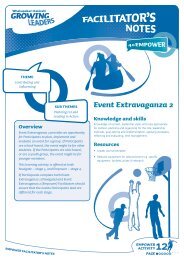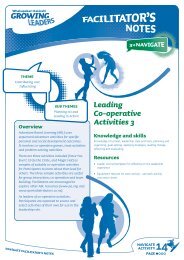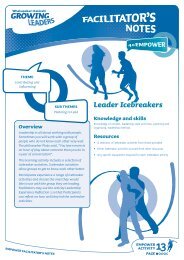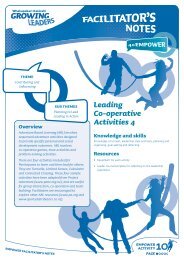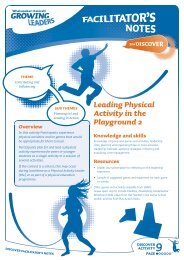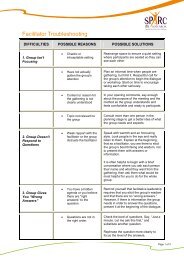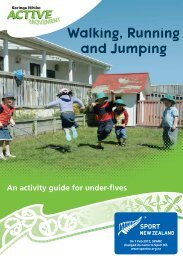An Introduction to Active Movement Koringa Hihiko - Sport New ...
An Introduction to Active Movement Koringa Hihiko - Sport New ...
An Introduction to Active Movement Koringa Hihiko - Sport New ...
You also want an ePaper? Increase the reach of your titles
YUMPU automatically turns print PDFs into web optimized ePapers that Google loves.
On 1 Feb 2012, SPARC<br />
changed its name <strong>to</strong> <strong>Sport</strong> NZ.<br />
www.sportnz.org.nz
Acknowledgements<br />
SPARC (<strong>Sport</strong> and Recreation <strong>New</strong> Zealand) express their sincere appreciation <strong>to</strong> the people and organisations that<br />
contributed both directly and indirectly <strong>to</strong> this <strong>Active</strong> <strong>Movement</strong> resource.<br />
SPARC wishes <strong>to</strong> thank the members of the National Early Childhood and Physical Activity Reference Group who have<br />
dedicated their time and energy <strong>to</strong> developing these recommendations. In particular, Sue Murray (Chair), for her<br />
commitment and efforts <strong>to</strong> capture the rich and unique diversity of <strong>New</strong> Zealand within the pages of <strong>Active</strong> <strong>Movement</strong>.<br />
Copyright SPARC 2009<br />
First published May 2004<br />
ISBN 1-877356-28-X
1<br />
Contents<br />
Foreword<br />
Contents<br />
How <strong>to</strong> Use this Document 3<br />
<strong>Introduction</strong> 4<br />
What is <strong>Active</strong> <strong>Movement</strong>? 5<br />
Where <strong>Active</strong> <strong>Movement</strong><br />
Begins 9<br />
The Developing Brain 10<br />
<strong>Active</strong> <strong>Movement</strong><br />
Develops the Brain 12<br />
<strong>Active</strong> Child, <strong>Active</strong> Learner 14<br />
Infants and Toddlers 15<br />
Young Children 21<br />
Exploring Fundamental<br />
<strong>Movement</strong> Skills 24<br />
<strong>Active</strong> Adult,<br />
<strong>Active</strong> Educa<strong>to</strong>r 28<br />
Growing Through<br />
Challenge and Experience 30<br />
Increasing <strong>Active</strong> <strong>Movement</strong><br />
Complexity 31<br />
The Success Platform for<br />
<strong>Active</strong> <strong>Movement</strong> 32<br />
Outcomes of <strong>Active</strong><br />
<strong>Movement</strong> 34<br />
Nurturing <strong>Active</strong> Children 36<br />
Recommendations<br />
For Parents 36<br />
Recommendations for the<br />
Centre Educa<strong>to</strong>r 38<br />
<strong>Active</strong> Communities 40<br />
<strong>Active</strong> <strong>Movement</strong> Settings 41<br />
Resources 52<br />
Key Concepts 53<br />
Suggested Readings 56<br />
Foreword<br />
We are born <strong>to</strong> move. It’s one of the first things a child<br />
discovers and learns <strong>to</strong> do. Quality movement experiences<br />
are an essential part of a child’s development, and are just<br />
as important for newborns as for older children. Moving and<br />
physical activity assist with the healthy growth of a child’s<br />
brain and body – and have an impact on a child’s social,<br />
emotional, physiological, spiritual, cognitive and physical<br />
abilities, and behaviour.<br />
Children are curious, and have a desire <strong>to</strong> experience and<br />
learn about the world around them. We need <strong>to</strong> ensure that<br />
a fun and creative environment is available for our children<br />
so they can develop the confidence and competence <strong>to</strong><br />
move, play and be active.<br />
The <strong>Active</strong> <strong>Movement</strong> resources are designed <strong>to</strong> provide<br />
young children with opportunities <strong>to</strong> experience quality<br />
physical activities in a fun environment. <strong>An</strong> <strong>Introduction</strong> <strong>to</strong><br />
<strong>Active</strong> <strong>Movement</strong> is a resource that can be used by parents,<br />
grandparents, teachers and caregivers. By engaging children<br />
in <strong>Active</strong> <strong>Movement</strong> activities, you will be helping <strong>to</strong> create<br />
the foundations for a life-long involvement in physical<br />
activity – you could even be helping <strong>to</strong> build <strong>to</strong>morrow’s<br />
high performance athletes.<br />
Peter Miskimmin<br />
Chief Executive SPARC
2<br />
If I had my child <strong>to</strong> raise over again<br />
If I had my child <strong>to</strong> raise all over again,<br />
I’d finger paint more, and point the finger less.<br />
I’d do less correcting, and more connecting.<br />
I’d take my eyes off my watch,<br />
and watch with my eyes.<br />
I would care <strong>to</strong> know less,<br />
and know <strong>to</strong> care more.<br />
I’d take more hikes, and fly more kites.<br />
I’d s<strong>to</strong>p playing serious, and seriously play.<br />
I’d run through more field, and gaze at more stars.<br />
I’d do more hugging, and less tugging.<br />
I would be firm less often, and affirm much more.<br />
I’d build self-esteem first, and the house later.<br />
I’d teach less about the love of power,<br />
<strong>An</strong>d more about the power of love.<br />
Diane Loomans “Full Esteem Ahead” 1994
3<br />
How <strong>to</strong> use<br />
this document<br />
This book is designed <strong>to</strong> raise awareness about the importance<br />
of movement in the early years of life. It will explore the role<br />
movement plays in human development and show how active<br />
movement is essential for helping your child <strong>to</strong> reach his or her<br />
potential.<br />
The diagram below illustrates the information journey though<br />
this resource. This is the first of many guides <strong>to</strong> exploring<br />
active movement. It is hoped that by making the journey <strong>to</strong><br />
understanding why active movement is so important, the guardians<br />
of children will pursue opportunities <strong>to</strong> lead healthy, active lives.<br />
SECTION D<br />
Fundamental<br />
movement skills<br />
SECTION E<br />
Being a<br />
role model<br />
p21<br />
p28<br />
SECTION I<br />
Recommendations for<br />
Educa<strong>to</strong>rs<br />
SECTION C<br />
What is the<br />
midline and why<br />
is it important?<br />
p38<br />
SECTION F<br />
Challenge<br />
and growth<br />
p20<br />
p30<br />
SECTION A<br />
<strong>Introduction</strong> <strong>to</strong><br />
<strong>Active</strong> <strong>Movement</strong><br />
SECTION B p10<br />
<strong>Movement</strong> and<br />
the Brain – how we<br />
develop<br />
p4<br />
p34<br />
SECTION G<br />
Outcomes of<br />
<strong>Active</strong> <strong>Movement</strong><br />
p36<br />
SECTION H<br />
Recommendations<br />
for Parents<br />
SECTION J<br />
Recommendations<br />
for Environment<br />
providers<br />
p40
4<br />
SECTION A<br />
<strong>Introduction</strong><br />
Children are born <strong>to</strong> move and in their early years they have<br />
an insatiable desire <strong>to</strong> move and learn about themselves<br />
and their relationship <strong>to</strong> the environment in which they<br />
live. <strong>Movement</strong> is the basis of who we are <strong>to</strong>day because it<br />
develops and strengthens the body and brain as we grow<br />
through childhood. By parents and caregivers being loving,<br />
caring, knowledgeable and respectful about the importance<br />
of movement, children, from before birth, will begin <strong>to</strong><br />
move and learn through their movement. This will<br />
establish in children the wonder and delight of learning<br />
<strong>to</strong> treasure, honour and respect their body for life-long<br />
health and wellbeing.<br />
Our society is evolving rapidly and it is crucial <strong>to</strong> ensure<br />
that our children, our greatest treasure of all, are able <strong>to</strong><br />
grow, move and develop as they were intended. <strong>Sport</strong> and<br />
Recreation <strong>New</strong> Zealand (SPARC) has initiated the concept<br />
of <strong>Active</strong> <strong>Movement</strong> for all infants, <strong>to</strong>ddlers and young<br />
children in <strong>New</strong> Zealand so they have the foundation <strong>to</strong><br />
successfully develop and learn:<br />
“To grow up as competent and confident learners and<br />
communica<strong>to</strong>rs, healthy in mind, body and spirit, secure in<br />
their sense of belonging and in the knowledge that they<br />
make a valued contribution <strong>to</strong> society” 1 .<br />
This resource has been written <strong>to</strong> share information,<br />
stimulate interest and promote <strong>Active</strong> <strong>Movement</strong> in Aoteroa<br />
<strong>New</strong> Zealand for parents, educationalists and recreation<br />
providers involved with children in their early years.<br />
1<br />
Te Whàriki He Whàriki Mãtauranga<br />
Mòngà Mokopuna o Aotearoa Early<br />
Childhood Curriculum.
SECTION A<br />
5<br />
What is <strong>Active</strong><br />
<strong>Movement</strong>/<br />
<strong>Koringa</strong> <strong>Hihiko</strong>?<br />
The physical activity needs of young children are quite<br />
different from the needs of older children and adults.<br />
SPARC’s new term <strong>Active</strong> <strong>Movement</strong>/<strong>Koringa</strong> Hihoko<br />
includes the development of heart, lungs, muscles, bones<br />
and use of energy. However, <strong>Active</strong> <strong>Movement</strong> also<br />
acknowledges that positive early movement experiences<br />
impact on the way infants, <strong>to</strong>odlers and young children<br />
learn and grow.<br />
<strong>Active</strong> <strong>Movement</strong> in early childhood is about:<br />
> knowing the whole child – their strengths and interests;<br />
> the learning and practising of fundamental<br />
movement skills;<br />
> the contribution that movement makes <strong>to</strong> brain, sensory<br />
development and learning;<br />
> developing positive internal motivation for long term<br />
health and wellbeing;<br />
> appreciating the child as both an intellectual and<br />
social being;<br />
> movement being meaningful, relevant and respectful for<br />
the child and family;<br />
> children becoming familiar with a bicultural/multicultural<br />
movement landscape;<br />
> the weaving through all learning experiences of our rich<br />
cultural heritages of the peoples of Aotearoa<br />
<strong>New</strong> Zealand.<br />
<strong>Active</strong> <strong>Movement</strong><br />
is engaging in quality<br />
physical movement<br />
experiences which<br />
develop and enhance<br />
the spiritual, emotional,<br />
social, cognitive and<br />
physiological growth<br />
of the child. <strong>Active</strong><br />
movement embodies<br />
the whole child.
6<br />
SECTION A<br />
Learning <strong>to</strong> move and acquiring movement skills<br />
are the physical areas of <strong>Active</strong> <strong>Movement</strong>.<br />
Children in fact receive multi-sensory stimulation<br />
which enables them <strong>to</strong> learn about relationships<br />
with themselves and their bodies, their peers,<br />
objects, time, their families, whanau, and places.<br />
Positive and rich active movement experiences<br />
enable young children <strong>to</strong> know and grow in joy<br />
and playfulness, <strong>to</strong> exude vitality, and <strong>to</strong> develop<br />
their imagination and wonder. Inner or spiritual<br />
qualities gained through encouragement and<br />
success-orientated movement experiences empower<br />
young children. This establishes confident, competent<br />
children, who know motivation and perseverance, and are<br />
able <strong>to</strong> take challenges and suitable risks in all areas of their<br />
learning.<br />
<strong>Active</strong> <strong>Movement</strong> involvement provides many opportunities<br />
<strong>to</strong> celebrate and develop understandings about aspects<br />
of the arts, tikanga and te reo Màori. Experiences can<br />
reflect and celebrate the cultures and communities that<br />
are represented in our diverse country. <strong>Active</strong> <strong>Movement</strong> in<br />
<strong>New</strong> Zealand is the medium that can reflect the best of all<br />
of our worlds. Communicating with children’s families and<br />
communities is at the heart of establishing and supporting<br />
our children in ensuring that they become the active movers<br />
they were born <strong>to</strong> be.<br />
Just as the principles and strands of the early childhood<br />
curriculum document He Whàriki Màtauranga Mòngà<br />
Mokopuna o Aotearoa are linked and woven <strong>to</strong>gether<br />
in children’s learning, so <strong>to</strong>o are the sections of this<br />
resource inseparable from each other. Developing <strong>Active</strong><br />
<strong>Movement</strong> skills and the love of movement and the outdoor<br />
environment, requires knowledgeable, collective input from<br />
parents, caregivers, whanau, local and central government.
SECTION A<br />
7<br />
The challenge for our future development and quality<br />
of life as we move in<strong>to</strong> the twenty-first century is <strong>to</strong><br />
be knowledgeable about and value the importance of<br />
<strong>Active</strong> <strong>Movement</strong> and suitable nutrition <strong>to</strong> all learning<br />
and development. Modern life with its mass explosion of<br />
technological advancements has many advantages and<br />
disadvantages that create inactive environments for children<br />
in the early years and their later teen years. Strategies<br />
critical <strong>to</strong> countering the sedentary environment that our<br />
technological age is imposing on us are central <strong>to</strong> this.<br />
The amount of time children in their early years spend on<br />
<strong>Active</strong> <strong>Movement</strong> and physical activity has decreased for<br />
many reasons, including<br />
> changing parenting trends, styles and parenting aids;<br />
> the creation of new pastimes and games such as<br />
computers and game consoles;<br />
> limited opportunities for play;<br />
> ever-increasing pressures on time;<br />
> inactive role models;<br />
> over concern for safety.<br />
We know active people are<br />
healthier and can live longer.<br />
The World Health Organization<br />
identifies children and<br />
young people as a specific<br />
population group that must<br />
be supported <strong>to</strong> be<br />
physically active. The<br />
<strong>New</strong> Zealand Health<br />
Strategy identifies physical activity as a priority, and children<br />
and young people have been prioritised within the Ministry<br />
of Health’s Healthy Eating – Healthy Action Strategy 2003.<br />
<strong>Active</strong> <strong>Movement</strong><br />
plays the foundational<br />
role in early childhood<br />
development in<br />
Aotearoa <strong>New</strong> Zealand.
8<br />
SECTION A<br />
Disposition<br />
is a tendency <strong>to</strong> exhibit<br />
frequently, consciously,<br />
and voluntarily, the<br />
motivation, attitudes,<br />
values and habits that<br />
all play key roles in<br />
guiding the person <strong>to</strong><br />
be involved.<br />
For an <strong>Active</strong> <strong>Movement</strong><br />
disposition, the key<br />
is the acquiring of<br />
physical skills and the<br />
feeling of joy that<br />
movement brings.<br />
The health benefits of being physically active and eating<br />
well are becoming recognised as important <strong>to</strong> public health<br />
promotion and the prevention of illness. There is clear<br />
evidence that increasing physical activity in populations can<br />
result in health benefits particularly in:<br />
> maintaining a healthy weight;<br />
> cardiovascular disease prevention;<br />
> diabetes prevention and control;<br />
> primary prevention of some cancers;<br />
> injury prevention and control;<br />
> promotion of positive mental health.<br />
Research indicates that children who develop the key<br />
movement skills and experience the joy of moving, gain<br />
physical confidence and competence and will participate<br />
in physical activity and enjoy the many benefits an active<br />
life provides. The extra incentive for assisting children <strong>to</strong><br />
become confident and competent movers is that these<br />
children are more likely <strong>to</strong> lead physically active lifestyles in<br />
the future 2 . Early childhood research reveals an opportunity<br />
in these early years <strong>to</strong> create active learning, moving,<br />
dispositions. Damaged <strong>Active</strong> <strong>Movement</strong> dispositions are<br />
extremely difficult <strong>to</strong> reverse.<br />
2<br />
See current research example<br />
in International Journal of <strong>Sport</strong>s<br />
Medicine 2003; 24:499-505.
SECTION A<br />
9<br />
Where <strong>Active</strong><br />
<strong>Movement</strong>/<strong>Koringa</strong><br />
<strong>Hihiko</strong> Begins<br />
<strong>Movement</strong> begins very early in utero when the developing<br />
fetus learns about gravity. In fact, balance, awareness and<br />
sensory systems of the body begin their development within<br />
weeks of conception. After a child is born, movement<br />
progresses further as the hands and feet and the core<br />
muscles of the s<strong>to</strong>mach and back as well as the senses of<br />
vision, hearing, <strong>to</strong>uch, taste and smell develop.<br />
This extends the world around<br />
the baby so the surrounding<br />
environment can be explored<br />
and interacted with.<br />
Involuntary reflexes assist the<br />
infant <strong>to</strong> survive birth, cope<br />
with the demands of gravity,<br />
and the early months of life (eg<br />
the sucking and hand-<strong>to</strong>-mouth<br />
reflexes). These reflexes also<br />
provide the preliminary ‘practising’<br />
for later learning and development.<br />
As an infant gains voluntary control<br />
over their body by having many<br />
positive opportunities <strong>to</strong> explore<br />
movement, these involuntary reflexes<br />
will be switched off or inhibited. This makes way for the<br />
brain and body <strong>to</strong> control the higher levels of movement<br />
and for higher learning <strong>to</strong> take place.
10<br />
SECTION B<br />
<strong>Active</strong> <strong>Movement</strong> experiences play a large role in developing<br />
the senses. The newborn baby is not aware that sound<br />
and movement, vision and <strong>to</strong>uch are separate sensations.<br />
<strong>Movement</strong> is the child’s first language and the more<br />
proficient they become in this first language, the better they<br />
will develop other powers of expression, exploration and<br />
development.<br />
The range of <strong>Active</strong> <strong>Movement</strong> and activity levels will<br />
continue <strong>to</strong> expand as the child gains more control over<br />
their body’s movements, learns and acquires key physical<br />
skills, has opportunities <strong>to</strong> practice and begins <strong>to</strong> explore the<br />
world around them.<br />
Human<br />
development is<br />
greatly influenced<br />
by early experiences<br />
which fine-tune brain<br />
structures. Genetics<br />
and environmental<br />
experience are partners<br />
in human development.<br />
3<br />
Carnegie Corporation<br />
“Starting Points” 1994.<br />
4<br />
Carla Hannaford<br />
“Smart Moves” 1995.<br />
The Developing Brain<br />
Research can now verify that positive movement<br />
experiences, positive sensory stimulation and adequate<br />
nutrition are vital <strong>to</strong> the developing brain and body of the<br />
growing child. A human brain, given a good foundation,<br />
can continue <strong>to</strong> adapt and expand for a lifetime.<br />
Early research in the 1990s in<strong>to</strong> the functioning and<br />
the effect of the environment on the brain provided<br />
new insights in<strong>to</strong> how the brain develops. The research<br />
showed that before the age of one year there is rapid,<br />
extensive and long-lasting brain development that is greatly<br />
influenced by the environment. 3 These findings challenged<br />
old assumptions about the brain and how a child learns.<br />
Continued research by neuroscientists, psychologists and<br />
movement specialists can now verify that movement,<br />
positive stimulation and nurturing are essential for growing<br />
the brain and developing higher brain functions. 4
SECTION B<br />
11<br />
OLD THINKING<br />
How a brain develops depends on genes<br />
you were born with.<br />
The experiences you have before the age<br />
of three have a limited impact on later<br />
development.<br />
A secure relationship with the primary<br />
caregiver creates a favourable context for<br />
early development.<br />
Brain development is linear: the brain’s<br />
capacity <strong>to</strong> learn and change grows<br />
steadily as an infant progresses <strong>to</strong><br />
adulthood.<br />
A <strong>to</strong>ddler’s brain is much less active than<br />
the brain of a college student.<br />
A child who walks early is going <strong>to</strong> be<br />
smarter than children not walking at the<br />
same age.<br />
NEW THINKING<br />
How a brain develops hinges on a complex<br />
interplay between genes you were born<br />
with and the experiences you have.<br />
Early experiences have a decisive impact on<br />
the architecture of the brain, and on the<br />
nature and extent of adult capacities.<br />
Early interactions don’t just create the<br />
context, they directly affect the way the<br />
brain is “wired”.<br />
Brain development is non-linear: there are<br />
prime times for acquiring different kinds of<br />
knowledge and skills.<br />
By the time children reach age three,<br />
their brains are twice as active as those<br />
of adults. Activity levels drop during<br />
adolescence.<br />
Children develop at different speeds<br />
and this is not always an indica<strong>to</strong>r of<br />
intelligence or cognitive potential.
12<br />
SECTION B<br />
<strong>Active</strong> <strong>Movement</strong>/<br />
<strong>Koringa</strong> <strong>Hihiko</strong><br />
Develops the Brain<br />
Opportunities for <strong>Active</strong> <strong>Movement</strong> from birth for all<br />
children are essential for brain development. Every<br />
movement made, makes connections in the mind/body<br />
system. <strong>Active</strong> <strong>Movement</strong> will strengthen the connections<br />
within the brain and the body. The development of these<br />
connections is vital for memory, sensory development,<br />
communication between the two sides of the brain,<br />
processing of information,<br />
participation in the arts<br />
and the later formal<br />
learning of reading,<br />
writing and mathematics.<br />
<strong>Active</strong> movement<br />
increases relaxation that<br />
allows the brain <strong>to</strong> process<br />
more efficiently and assists<br />
retention and learning.<br />
From the time of<br />
conception until death<br />
the brain can continue<br />
<strong>to</strong> grow and develop<br />
brain cells (neurons) and<br />
connecting pathways.<br />
Neural pathways are<br />
increased and strengthened<br />
with each new experience.<br />
More connections, mean<br />
more ways information<br />
can be processed.
SECTION B<br />
13<br />
Neurons and neural<br />
pathways that have been<br />
prepared by the brain<br />
for use will be “pruned”<br />
out if they are not used<br />
regularly.<br />
The environment and<br />
explora<strong>to</strong>ry movement<br />
experiences influence<br />
how the brain wires itself<br />
up after birth.<br />
<strong>Active</strong> <strong>Movement</strong><br />
increases oxygen and<br />
glucose (the fuels) <strong>to</strong><br />
the brain.<br />
Childhood <strong>Active</strong><br />
<strong>Movement</strong> prepares<br />
the brain for language,<br />
art, maths, science,<br />
movement, group abilities<br />
and intelligences.<br />
<strong>Active</strong> <strong>Movement</strong><br />
triggers a transmitter that<br />
enhances learning by<br />
boosting the ability of the<br />
brain cells <strong>to</strong> communicate<br />
with each other.<br />
Repetition of<br />
experiences enhances<br />
retention in the brain.
14<br />
SECTION B<br />
<strong>Active</strong> Child,<br />
<strong>Active</strong> Learner<br />
How we consider, respect, think about,<br />
feel about, know about, and perceive our<br />
children affects the development of the<br />
growing child. By seeing and knowing that<br />
every child in our care is loving and beautiful,<br />
and a gift that we have been given <strong>to</strong> support<br />
and nurture, we can ensure children receive<br />
the wisest and best opportunities <strong>to</strong> reach and<br />
realise their potential.<br />
The young child<br />
learns movement skills<br />
through their active<br />
movement. Practice,<br />
and repeating the<br />
movement many<br />
times, strengthens and<br />
increases all abilities in<br />
movement and learning.<br />
Children who are supported, loved and<br />
respected, and provided with a broad range of<br />
<strong>Active</strong> <strong>Movement</strong> experiences that are inclusive<br />
of all, are more likely <strong>to</strong> realise their potential<br />
as healthy individuals, as members of families and<br />
communities, and as active participants in all forms of physical<br />
activity, the arts and sport, as leaders and as volunteers.<br />
Every opportunity and every interaction with the<br />
environment of peers, adults and objects provides some<br />
form of learning for the young child from birth. <strong>Movement</strong><br />
is the basis for all this learning <strong>to</strong> take place. Whether it<br />
be the smallest sensory movement of an eye, a smell, an<br />
encouraging <strong>to</strong>uch or a large movement such as that of a<br />
hand or foot, it will be a learning experience. The brain and<br />
body orchestrates these movements, which culminates in<br />
their continued growing and strengthening in the process.<br />
A loving, and pleasure-filled environment provides the best<br />
opportunities for children <strong>to</strong> learn in their early years. Each<br />
infant, <strong>to</strong>ddler and young child will grow, develop and<br />
learn in their own special way, influenced by the society<br />
and culture that they are born in<strong>to</strong>. However there are key
SECTION B<br />
15<br />
fundamental skills that help children <strong>to</strong> achieve confidence<br />
and competency in their bodies and <strong>to</strong> prepare for higher<br />
formal learning.<br />
For example: providing infants with plenty of time lying on<br />
the floor, front and back and side, progressing <strong>to</strong> rolling<br />
over, creeping, crawling, and sitting, all without aids, is<br />
essential for being able <strong>to</strong> use both sides of the body, brain<br />
and senses in a coordinated way.<br />
Infants and Toddlers<br />
Generally, baby’s muscles are both strong and coordinated<br />
from birth onwards and need constant movement, stimulus<br />
and nourishment <strong>to</strong> allow them <strong>to</strong> grow powerfully and<br />
naturally. As the baby’s muscles develop from the head<br />
downwards and from the centre of the chest outwards,<br />
<strong>Active</strong> <strong>Movement</strong> experiences will follow this development.<br />
The infant learns <strong>to</strong> control the head and neck muscles first.<br />
Control over other parts of the body develops downwards<br />
with the legs and feet being last. Infants have better control<br />
of their body movements before they can accomplish finer<br />
manipulations of their fingers. Holding a crayon or pencil <strong>to</strong><br />
express with, will be more successful with the development<br />
of the large muscles of the upper body helped through lying<br />
on the s<strong>to</strong>mach, crawling, hanging, and climbing. These are<br />
all foundation skills for later learning.<br />
Opportunity, time<br />
and practice are basic<br />
and vital requirements<br />
<strong>to</strong> achieve and ensure<br />
that <strong>Active</strong> <strong>Movement</strong><br />
is developed in every<br />
child’s day.
16<br />
SECTION B<br />
“The richer our<br />
sensory environment<br />
and the greater our<br />
freedom <strong>to</strong> explore it,<br />
the more intricate will<br />
be the patterns for<br />
learning, thought<br />
and creativity”.<br />
Carla Hannaford,<br />
Smart Moves<br />
The infant, going from lying <strong>to</strong> standing in the first part of<br />
its life, experiences incredible strength and coordination<br />
accomplishments. It is at this time that there is a huge<br />
elaboration of nerve networks developed throughout the<br />
body and brain. It is the establishment and strengthening of<br />
these nerve networks that ensures the body and brain are<br />
given every possible opportunity for maximum potential in<br />
all learning.<br />
Moving, being moved, or being in contact with stimuli<br />
that are in motion, activates our senses. We see because<br />
our eyes move, we hear because waves of sound strike the<br />
eardrum, causing it <strong>to</strong> vibrate. Fluid in our balance systems<br />
(in our inner ears) and mechanisms in our muscles detect<br />
movement and where the body is in space. The brain is<br />
continually receiving sensory information from the body and<br />
surroundings; it then deciphers the messages and organises<br />
purposeful responses.<br />
Daily experiences that develop sensory systems through <strong>Active</strong><br />
<strong>Movement</strong> are crucial <strong>to</strong> gaining an understanding of the<br />
surrounding world. It is important for the child <strong>to</strong> progress in<br />
development at their own pace and not be rushed, as neural<br />
pathways take time <strong>to</strong> develop and strengthen.<br />
The many sensory systems of the body work independently<br />
and as a team <strong>to</strong> accomplish all tasks. Hearing, smelling,<br />
and tasting combine with the vision, the balance and body<br />
awareness systems <strong>to</strong> enable the child <strong>to</strong> survive, <strong>to</strong> learn,<br />
and <strong>to</strong> function efficiently.
SECTION B 17
18 SECTION B<br />
Balance and movement:<br />
the vestibular sense<br />
The neck, eyes and body provide<br />
information about gravity and space,<br />
balance and movement. They help us <strong>to</strong><br />
learn about our head and body position in<br />
relation <strong>to</strong> the ground.<br />
The vestibular sense can be stimulated and<br />
developed by lying on the floor on the<br />
tummy, side and back, belly wiggling and<br />
squirming, then rolling over in both directions.<br />
Daily inclusion of slow spinning, swinging<br />
(carefully placing the child where its<br />
head is lower than the rest of its body<br />
will also enhance this development).<br />
NB. Wide-awake babies require plenty<br />
of time on s<strong>to</strong>machs in order <strong>to</strong> explore and<br />
strengthen what their bodies can do.<br />
Touch: the tactile sense<br />
The tactile sense provides information<br />
through the surface of the skin, from head<br />
<strong>to</strong> <strong>to</strong>e, about the texture, shape and size of<br />
objects in the environment as well as one’s<br />
self (body awareness).<br />
This sense connects with vision <strong>to</strong> interpret<br />
how objects feel.<br />
Experiences from birth include: massage,<br />
being cuddled, exposure <strong>to</strong> different<br />
sensations, feathers, wind, soft material,<br />
bare feet, finger plays, active body<br />
awareness games, hands-on experiences,<br />
messy play, rough and tumble play.
SECTION B<br />
19<br />
Vision<br />
The ability of the eyes <strong>to</strong> learn <strong>to</strong> work<br />
<strong>to</strong>gether. The eyes must be actively moving<br />
for learning <strong>to</strong> occur. 90% of vision takes<br />
place in the brain as sight forms networks<br />
with other senses.<br />
The vision sense can be stimulated by<br />
lying on the tummy and the back for child<br />
<strong>to</strong> search the environment. Searching for<br />
stationary and moving objects, in and just<br />
out of reach. (Develops eye muscles).<br />
NB. TV locks children’s eyes in<strong>to</strong> one position<br />
and the full range of eye movement is not<br />
activated. It also inhibits visualisation.<br />
Body position:<br />
the proprioceptive sense<br />
The proprioceptive sense provides<br />
information through joints, about body<br />
position, force, direction and movement of<br />
body parts. Its function is <strong>to</strong> increase body<br />
awareness and coordinate gross and fine<br />
mo<strong>to</strong>r experiences.<br />
It assists with body expression, and being<br />
able <strong>to</strong> move efficiently and economically.<br />
When a child trusts their body, they feel<br />
connected and safe and secure.<br />
Carrying, pushing, pulling, and other<br />
vigorous <strong>Active</strong> <strong>Movement</strong> experiences<br />
develop this sense.
20 SECTION C<br />
Learning <strong>to</strong> Cross the Midline of the Body<br />
With opportunities <strong>to</strong> explore their bodies,<br />
senses and surroundings, the developing child<br />
will gain ability in using both sides of their<br />
bodies in coordinated and different ways. For<br />
example waving two arms at the same time,<br />
kicking feet in an alternate pattern, crawling,<br />
climbing stairs, throwing a beach ball, jumping<br />
two feet <strong>to</strong> two feet.<br />
Becoming proficient at these experiences enables<br />
the ability <strong>to</strong> cross the midline of the body. This<br />
is using the eye, hand, or foot of one side of the<br />
body in the space of the other, eye, hand or foot.<br />
This skill is essential for the two hemispheres of the<br />
brain <strong>to</strong> be able <strong>to</strong> communicate with each other<br />
and <strong>to</strong> pass information back and forth.<br />
How will crossing the midline help your child? By<br />
learning <strong>to</strong> cross the midline a child’s abilities will be<br />
enhanced and as an older child it will help with:<br />
> eye-hand, eye-foot movements eg, throwing, catching,<br />
kicking balls, scissor cutting, threading, gluing, and writing;<br />
> following instructions – learning <strong>to</strong> listen then being able<br />
<strong>to</strong> carry out the instructions;<br />
> developing spatial awareness concepts such as left<br />
and right;<br />
> vision – three dimensional viewing and following objects<br />
with the eyes (tracking) and the two eyes learning <strong>to</strong><br />
work <strong>to</strong>gether. This is essential <strong>to</strong> have acquired before<br />
the child begins <strong>to</strong> learn <strong>to</strong> read and <strong>to</strong> be able <strong>to</strong><br />
comprehend what they are reading. (Reading being a<br />
two dimensional activity does not develop the full range<br />
of eye movements);<br />
> cross-pattern movements eg, biking with pedals,<br />
crawling, stair climbing, marching, swimming and<br />
climbing trees safely;
SECTION D<br />
21<br />
> learning <strong>to</strong> direct one part of the body <strong>to</strong> move<br />
according <strong>to</strong> plan while the other parts remain still or<br />
does something different. The child is able <strong>to</strong> do this<br />
when of the fetal reflexes are lost and by practising<br />
cross-pattern movements;<br />
> letters and numbers are written in the correct direction<br />
and the full page is used;<br />
> concepts of print – knowing which way up a book is and<br />
where print begins;<br />
> tying shoe laces.<br />
Young Children<br />
With beginning dispositions for <strong>Active</strong> <strong>Movement</strong> in place<br />
and the body learning <strong>to</strong> be aware, strong and coordinated,<br />
the young child is able <strong>to</strong> expand, challenge and explore the<br />
capabilities of their body. This increasing ability in movement<br />
and the child’s instinctive desire <strong>to</strong> move provides further<br />
opportunities <strong>to</strong> develop their ever-growing brain/body<br />
system.<br />
Fundamental <strong>Movement</strong> Skills<br />
As young children move in<strong>to</strong> more conscious control of their<br />
movement they can develop their fundamental movement<br />
skills. These are the foundation skills <strong>to</strong> more specialised,<br />
complex skills used in the play, games, sports, dance,<br />
gymnastics, outdoor education and physical recreation<br />
experiences that they will be involved in later in their lives.<br />
Fundamental movement skills also establish and strengthen<br />
neural pathways, develop physical fitness and contribute <strong>to</strong><br />
socio-cultural awareness, and language attainment.<br />
The arts of poi,<br />
tira, titi <strong>to</strong>rea, haka, and<br />
waiata include various<br />
movement patterns and<br />
are essential skills<br />
for all children <strong>to</strong><br />
acquire and become<br />
proficient at. There<br />
are many carry-overs<br />
in<strong>to</strong> other movement<br />
patterns, for example,<br />
by learning poi and<br />
takahia movements,<br />
children develop the<br />
agility, coordination,<br />
flexibility, and wrist<br />
strength, which can be<br />
carried over <strong>to</strong><br />
rope skipping.<br />
From National Heart<br />
Foundation “Jump Rope<br />
for Heart”.
22<br />
SECTION D<br />
Fundamental movement skills can be learned through<br />
play and embedded in all early childhood experiences.<br />
Collaboration and cooperation between family, early<br />
childhood centre and the community provide the best<br />
opportunities for learning the fundamental movement skills.<br />
Learning fundamental movement skills is best supported<br />
when the family, early childhood centre and community<br />
work <strong>to</strong>gether.<br />
<strong>Active</strong> <strong>Movement</strong> involves learning <strong>to</strong> move the body<br />
efficiently, joyously, and with quality and control in many<br />
different ways. This involves trying out, thinking, making<br />
decisions, evaluating and persisting. Children who have<br />
competent physical skills are more likely <strong>to</strong> have feelings of<br />
self confidence and <strong>to</strong> know power within. This can flow on<br />
in<strong>to</strong> their approach <strong>to</strong> other aspects of their lives and also<br />
have a positive impact on their relationships with<br />
their peers.
SECTION D 23
24 SECTION D<br />
These are fundamental movement skills for all children:<br />
Locomo<strong>to</strong>r<br />
Moving the body from one<br />
location <strong>to</strong> another –<br />
walking, running, jumping,<br />
leaping, galloping, hopping<br />
Stability<br />
Moving or standing still with<br />
one body part attached <strong>to</strong><br />
ground or equipment –<br />
balancing, stretching,<br />
twisting, waiata movements,<br />
bending, turning, haka,<br />
rolling
SECTION D<br />
25<br />
Manipulation<br />
Imparting or receiving force<br />
from or <strong>to</strong> an object –<br />
throwing, catching, batting,<br />
poi, tira titi <strong>to</strong>rea, kicking,<br />
dribbling, bouncing<br />
<strong>Movement</strong> and body<br />
awareness<br />
Having knowledge of one’s<br />
own body parts and their<br />
movement capabilities in<br />
combination with being<br />
able <strong>to</strong> effectively respond<br />
<strong>to</strong> sensory information so a<br />
specific mo<strong>to</strong>r task is able<br />
<strong>to</strong> be performed<br />
Young children do not clearly separate learning <strong>to</strong> move<br />
from learning through their movement, where they learn<br />
about their self, their environment and world they live in.<br />
Young children learn holistically.
26 SECTION D<br />
Exploring Fundamental <strong>Movement</strong> Skills<br />
Exploration of <strong>Active</strong> <strong>Movement</strong> skills assists young learners<br />
<strong>to</strong> develop the ability <strong>to</strong> move in a variety of ways under<br />
a variety of circumstances. Constructing the how, where,<br />
with whom, or with what an <strong>Active</strong> <strong>Movement</strong> skill can<br />
be performed (mo<strong>to</strong>r planning) develops concepts and<br />
understanding of spatial and body awareness. Exploration is<br />
about testing all possibilities.<br />
Neurons and neural paths are also increased and strengthen<br />
with exploration.<br />
Exploration involves<br />
Effort<br />
How the body moves<br />
Eg, jumping fast, slow, heavy or soft, in waiata hand<br />
movements are fast or slow<br />
Space<br />
Where the<br />
body moves<br />
Eg, jumping high, low, backwards, sideways, wide, thin.<br />
Moving in the haka, forwards, backwards, <strong>to</strong> the side<br />
Relationships<br />
Moving with objects<br />
and people<br />
Eg, jumping In, out, over, under, mirroring, <strong>to</strong>gether, solo,<br />
group. Moving the rakau, up, down, in, out, in time with<br />
beat solo or with partner, group
SECTION D<br />
27
28 SECTION E<br />
<strong>Active</strong> Adult,<br />
<strong>Active</strong> Educa<strong>to</strong>r<br />
Strong, powerful, playful, joyful, curious, persistent,<br />
successful, challenge-taker, confident and competent.<br />
Hold this image of the child for a minute.<br />
Think of what <strong>Active</strong> <strong>Movement</strong> means<br />
How do you provide opportunities <strong>to</strong> move for a child<br />
in your care?<br />
How do you relate <strong>to</strong> this child in movement?<br />
What expectations for the child’s participation do you hold?<br />
Do you have the knowledge of how this child moves?<br />
How can you engage with this child <strong>to</strong> further develop skills<br />
in <strong>Active</strong> <strong>Movement</strong>?<br />
Remember that creating positive active movement<br />
dispositions during childhood will have life long benefits<br />
for health and wellbeing. By knowing about the way<br />
children learn key movement skills in the active movement<br />
environment, active adults are able <strong>to</strong> provide involvement<br />
for children that reflects the way children learn and the<br />
culture that they are growing up in. Adults, both parents<br />
and caregivers, in the active movement environment<br />
provide extremely strong and powerful role models.<br />
Actions and attitudes count as much as or even more than<br />
the words spoken.<br />
Children believe<br />
they are as capable<br />
as their parents and<br />
caregivers consider<br />
them <strong>to</strong> be.<br />
We know that children learn best when the parent or<br />
teacher is an active participant in the learning process.<br />
This is achieved by working in partnership with the child,<br />
providing knowledge and skills and knowing when <strong>to</strong> offer<br />
support. This means adults at times joining in the movement<br />
activity with joy, understanding the <strong>Active</strong> <strong>Movement</strong> skill<br />
components, providing challenges that extend each skill,<br />
and offering specific verbal feedback, instruction (at times)<br />
and support, while ensuring the child leads the experiences.
SECTION F<br />
29<br />
Children all grow and develop at different rates.<br />
Chronological age provides a guideline only for acquiring<br />
physical skills, as each child brings <strong>to</strong> the home and early<br />
childhood setting their own challenges, experiences, abilities<br />
and needs in movement. Children will learn and develop<br />
their movement skills through learning opportunities where<br />
they can be guided, encouraged and then able <strong>to</strong> practice<br />
with themselves, with other children and with adults. As<br />
active educa<strong>to</strong>rs be aware of this concept, so emphasis is<br />
put on the whole child’s learning.<br />
Children with disabilities have the same desire and need<br />
<strong>to</strong> develop physical skills and physical fitness. <strong>An</strong> <strong>Active</strong><br />
<strong>Movement</strong> approach develops basic knowledge and skills<br />
and presents simple experiences for all children, taking in<strong>to</strong><br />
account their individuality.<br />
Kids are more often disinvited<br />
than they are disinterested or disabled<br />
Dr William Watson Purkey, 2003.
30 SECTION F<br />
Growing through<br />
challenge and<br />
experience<br />
“Avoiding danger<br />
is no safer in the long<br />
run than outright<br />
exposure. Life is either a<br />
daring adventure,<br />
or nothing.”<br />
Helen Keller<br />
Success for children in the early years in <strong>Active</strong> <strong>Movement</strong><br />
relies above all upon the active educa<strong>to</strong>r and the<br />
opportunities and the role model provided. How the<br />
relationships are developed with the child and the<br />
environment, and the motivation <strong>to</strong> be involved culturally,<br />
physically, spiritually and knowledgeably underpin success<br />
for children. The young brain is fuelled on success and the<br />
enjoyment of the successes that they achieve.<br />
Success is not measured by how fast or far the child can<br />
learn <strong>to</strong> crawl, walk, run, jump or throw. It is measured<br />
by the smile on the child’s face upon achievement<br />
of accomplishing the skill and the desire <strong>to</strong> continue<br />
developing and exploring the skill.<br />
Contributing <strong>to</strong> success for the young active mover<br />
is recognition of the importance of challenge and<br />
risk-taking in their learning. Young children learn about<br />
the world, including what is safe and what is not,<br />
through firsthand experience. Research has shown that<br />
a willingness <strong>to</strong> take risks is linked <strong>to</strong> success in later life.<br />
Childhood is a time <strong>to</strong> learn how <strong>to</strong> adjust <strong>to</strong> change and<br />
take suitable risks. Risk-taking in a safe <strong>Active</strong> <strong>Movement</strong><br />
environment allows the child <strong>to</strong> gradually grow braver,<br />
develop fundamental movement skills, and build feelings of<br />
personal confidence, competence and independence. If an<br />
active educa<strong>to</strong>r is overly anxious, for instance, it is harder for<br />
the child <strong>to</strong> become a confident and curious individual. Even<br />
as children are taking risks and extending limits, they are<br />
learning by what they see the adults do.<br />
As challenge increases for the child so does the extensive<br />
interplay of neural pathways.
SECTION F<br />
31<br />
Increasing <strong>Active</strong> <strong>Movement</strong> Complexity<br />
For young children <strong>to</strong> learn, acquire and grow in <strong>Active</strong><br />
<strong>Movement</strong>, fundamental movement skills begin with the<br />
simple and gradually become more complex. This allows<br />
time for the body/brain systems <strong>to</strong> develop and strengthen.<br />
For example: Learning <strong>to</strong> catch progresses from the many<br />
opportunities a baby has in tracking a moving object on<br />
their fronts, backs and sides, watching and following a<br />
hanging ball or poi, learning <strong>to</strong> bounce, pat, and catch<br />
a large balloon, a beach ball, before experiencing a one-onone<br />
catching situation with a large soft ball with an adult.<br />
Problem solving (the brain’s favourite activity) in <strong>Active</strong><br />
<strong>Movement</strong> for the older child develops new awareness<br />
of how the body works and the effects it has on the<br />
exploration of skills. Having knowledge of each fundamental<br />
movement skill and how it develops is essential for<br />
encouraging problem solving.<br />
For example: Learning two-foot jumping – Can you jump<br />
using no arms, one arm, swinging arms up, head and eyes<br />
down? What happens if you carry a weight? Jump on<br />
different surfaces? When performing a takahia, how do you<br />
create the loud stamp?
32 SECTION F<br />
Using natural resources for some equipment such as<br />
flax balls with shells inside, and woven flax skipping<br />
ropes, reflects our bicultural heritage as well as providing<br />
opportunities <strong>to</strong> feel and use indigenous materials. Use and<br />
participate with real <strong>to</strong>ols such as titi <strong>to</strong>rea.<br />
Creating a success-orientated setting for <strong>Active</strong> <strong>Movement</strong><br />
ensures the child learns <strong>to</strong> gain control over their body and<br />
feels empowered <strong>to</strong> explore their environment. A relaxed<br />
environment that is a mixture of sensory and physical<br />
experiences will inspire interest and involvement that is<br />
fundamental <strong>to</strong> creating active, moving,<br />
learning dispositions.<br />
The Success Platform for<br />
<strong>Active</strong> <strong>Movement</strong><br />
Children will live up <strong>to</strong> what they believe of themselves.<br />
The context or setting that is created for active movement<br />
experiences affects how the child will participate and how<br />
that setting best serves their development. A positive and<br />
success-orientated setting will validate and support the<br />
child. <strong>Active</strong> <strong>Movement</strong> provides opportunities<br />
through experiences <strong>to</strong> learn qualities that are<br />
essential for growing up successfully in the<br />
world of the future.
SECTION F<br />
33<br />
Opportunity<br />
Time necessary for<br />
progress and advancement<br />
of skill in child<br />
Repetition/Practice<br />
The more often a<br />
movement skill is<br />
performed then the<br />
easier it becomes <strong>to</strong> do<br />
Assessment<br />
Through knowledgeable<br />
educa<strong>to</strong>rs and from the<br />
environment<br />
Challenge and<br />
problem solving<br />
Awakens and develops<br />
understanding, and<br />
resilience <strong>to</strong> succeed<br />
Persistence<br />
The driving force behind<br />
learning, practising and<br />
gaining movement skills<br />
Culture Awareness<br />
Incorporating the arts,<br />
language and games of<br />
a child’s rich heritage are<br />
respected and included in<br />
<strong>Active</strong> <strong>Movement</strong><br />
<strong>Active</strong><br />
<strong>Movement</strong><br />
Feedback<br />
Specific feedback of skill<br />
assists with development<br />
Encouragement<br />
Promotes and supports<br />
guidance that will incite the<br />
child in<strong>to</strong> action<br />
Assessment<br />
Success<br />
Joy<br />
Improving<br />
Increased<br />
motivation
34 SECTION G<br />
Outcomes of <strong>Active</strong><br />
<strong>Movement</strong>/<strong>Koringa</strong><br />
<strong>Hihiko</strong><br />
<strong>Active</strong> <strong>Movement</strong> establishes a physically fit body, mind and<br />
spirit, strengthens neural pathways and the senses for all<br />
growing children <strong>to</strong> participate in all areas of their growth,<br />
development and learning.<br />
<strong>Active</strong> movement in the early<br />
years is non-negotiable. As<br />
the following diagram shows,<br />
outcomes of <strong>Active</strong> <strong>Movement</strong><br />
include:<br />
> development of the<br />
senses<br />
> development of<br />
confidence and body<br />
awareness<br />
> understandings required<br />
for formal learning<br />
experiences.
SECTION G<br />
35<br />
Language and<br />
Communication<br />
Social, emotional development<br />
Maths<br />
concepts<br />
Eye, hand, foot<br />
coordination<br />
Literacy<br />
Science<br />
and<br />
technology<br />
Rhythm<br />
and<br />
music<br />
Confidence<br />
Body<br />
rhythm<br />
and timing<br />
Directionality<br />
Vision<br />
Spatial<br />
awareness<br />
<strong>Active</strong><br />
<strong>Movement</strong><br />
Skills<br />
Body<br />
awareness,<br />
image and<br />
control<br />
Problem<br />
solving<br />
Vestibular<br />
system<br />
Fitness<br />
Laterality<br />
Proprioception<br />
Thinking and learning<br />
Memory<br />
The arts<br />
Health<br />
and<br />
fitness<br />
Specialised sport and<br />
recreational skills
36 SECTION H<br />
Nurturing <strong>Active</strong><br />
Children<br />
Parents and caregivers can ensure the growing child has the<br />
best possible start <strong>to</strong> life by making a knowledgeable and<br />
loving commitment <strong>to</strong> active lifestyles for their children and<br />
themselves. The following suggestions can assist the educa<strong>to</strong>r<br />
<strong>to</strong> be actively involved and <strong>to</strong> make this commitment <strong>to</strong><br />
children for daily active movement participation.<br />
Recommendations for Parents<br />
1. Possess the active child image:<br />
From birth, babies are constantly learning <strong>to</strong> move and<br />
learning through their movement. Children will learn and<br />
grow as nature intended with parents holding a positive<br />
image of the moving and learning growing child.<br />
2. Provide daily opportunities:<br />
Daily active movement experiences dispersed throughout<br />
the child’s day will provide optimum growing and<br />
learning development. Time is necessary <strong>to</strong> learn <strong>Active</strong><br />
<strong>Movement</strong> skills.<br />
3. Create playfulness:<br />
Take time <strong>to</strong> play and enjoy your child developing in<br />
<strong>Active</strong> <strong>Movement</strong>.<br />
4. Create <strong>Active</strong> <strong>Movement</strong> traditions:<br />
Make <strong>Active</strong> <strong>Movement</strong> a tradition. Commit <strong>to</strong> and enjoy<br />
<strong>Active</strong> <strong>Movement</strong> as a family at least once a week, such<br />
as involvement in kapa haka, taking a walk – in the bush,<br />
along the beach, around the lake, at the river. Enjoy what<br />
Mother Earth has provided.
SECTION H<br />
37<br />
5. Use aids appropriately<br />
Limit the use of equipment that restricts a child’s natural<br />
ability <strong>to</strong> move and develop, for example, car seats are<br />
intended for the car and inappropriate use can limit a child’s<br />
opportunities for activities. Some aids may inhibit correct<br />
development of hips and legs, limit body rotation and have<br />
high accident rates.<br />
6. Avoid inactivity:<br />
We know that many hours of TV/video watching, playing on<br />
computers and game consoles, limits the development of<br />
the brain/body system as well as providing opportunities for<br />
extra food snacking. Set time limits and be selective.<br />
7. Be a positive role model:<br />
A young child’s appreciation of <strong>Active</strong> <strong>Movement</strong> begins<br />
with the parent. Find an activity that works for you –<br />
walking the dog, riding a bike, swimming, lifting weights,<br />
waka racing.
38 SECTION I<br />
Recommendations for the<br />
Centre Educa<strong>to</strong>r<br />
In the early childhood educational setting the parental<br />
suggestions influence your involvement and practice<br />
with the child. Strengthening positive concepts of <strong>Active</strong><br />
<strong>Movement</strong> through knowledgeable interactions and<br />
providing contextual environments where children can<br />
move and learn is essential. This will empower children with<br />
confidence and competence in themselves and their bodies<br />
abilities <strong>to</strong> move and learn.<br />
1. Possess the <strong>Active</strong> <strong>Movement</strong> image:<br />
Seeing the child as a unique, confident and competent<br />
active mover will ensure the setting and experiences that<br />
are co-created reflect this.<br />
2. Provide the <strong>Active</strong> <strong>Movement</strong> context:<br />
Positive experiences that underpin the social and<br />
cultural influences of children, family, whanau, and<br />
community will be more relevant, empowering, inclusive<br />
and meaningful.<br />
3. Value and plan for <strong>Active</strong> <strong>Movement</strong>:<br />
Having <strong>Active</strong> <strong>Movement</strong> domain knowledge and being<br />
committed <strong>to</strong> implementing <strong>Active</strong> <strong>Movement</strong> will<br />
ensure the setting is one where children are encouraged<br />
<strong>to</strong> value, care for and respect themselves and each other,<br />
are affirmed as individuals, and have opportunities <strong>to</strong><br />
contribute. When staff are in tune with where children<br />
are at, the teachable moments will be captured.<br />
4. “Playful” and active role models:<br />
Successful acquisition of fundamental <strong>Active</strong> <strong>Movement</strong><br />
skills is dependent upon the involvement of the positive<br />
and knowledgeable active educa<strong>to</strong>r. Learning is fostered<br />
through responsive and reciprocal relationships between<br />
teacher and child.
SECTION I<br />
39<br />
5. Recognise the holistic learning in <strong>Active</strong><br />
<strong>Movement</strong>:<br />
What outwardly appears <strong>to</strong> be a physical experience for<br />
children is actually interwoven with the cognitive, social,<br />
cultural, emotional and spiritual dimensions of learning<br />
and growing.<br />
6. Promote the use of te reo Màori, the arts<br />
and tikanga:<br />
Encourage the use of te reo Màori in <strong>Active</strong> <strong>Movement</strong><br />
experiences. For example, translate familiar words,<br />
instruction and directions. Explore and experience the<br />
arts and associated equipment. For example – poi,<br />
rakau, waiata and haka movements and understand the<br />
sacredness of these.<br />
7. Involving the family, whanau and community in<br />
<strong>Active</strong> <strong>Movement</strong>:<br />
Cultivate the sense<br />
of unity and identity<br />
between family and<br />
whanau through moving<br />
and learning <strong>to</strong>gether.<br />
Share knowledge of the<br />
games and activities of<br />
the diverse cultures in<br />
the centre.
40 SECTION J<br />
<strong>Active</strong> Communities<br />
The goal of this resource is for all <strong>New</strong> Zealanders <strong>to</strong> grow<br />
up being involved in <strong>Active</strong> <strong>Movement</strong> every day, in as many<br />
different ways as possible. The active community has a vital<br />
and significant place in moving <strong>to</strong>wards achieving this goal.<br />
Ensuring that children in their early years, their families, and<br />
their whanau, have the services and environments for <strong>Active</strong><br />
<strong>Movement</strong> opportunities will meet this goal. The challenge<br />
is <strong>to</strong> provide opportunities for, access <strong>to</strong> and support for<br />
<strong>Active</strong> <strong>Movement</strong> in a variety of settings other than the<br />
home and early childhood centre.<br />
Improving <strong>Active</strong> <strong>Movement</strong> settings will require knowledge<br />
about the development of a child in their early years. It is<br />
recommended that the other sections of the document,<br />
particularly the <strong>Active</strong> Child, <strong>Active</strong> Learner section, will assist<br />
in understanding and providing for the active child.
SECTION J<br />
41<br />
<strong>Active</strong> <strong>Movement</strong> Settings<br />
Children enjoy open space and the simple things in life<br />
with an energy and innocent enthusiasm that needs<br />
encouragement and support. Children are great users of our<br />
parks, swimming pools, playgrounds, open spaces, courts<br />
and sporting facilities. These experiences:<br />
> allow children <strong>to</strong> develop environmental awareness, an<br />
attachment and appreciation for the land and facilities;<br />
> provide opportunities for social gatherings and positive<br />
group activities;<br />
> provide safe environments for children <strong>to</strong> experience<br />
active movement;<br />
> assist parents and caregivers <strong>to</strong> give their children quality<br />
active movement opportunities otherwise out of reach;<br />
> provide a collective health benefit for the community;<br />
and<br />
> provide educational opportunities in an alternative<br />
educational medium and a method for addressing<br />
learning difficulties.<br />
Currently the focus tends centres <strong>to</strong> be on <strong>Active</strong> <strong>Movement</strong><br />
taking place at childcare centres or as a separate, special<br />
activity. The challenge is <strong>to</strong> provide access <strong>to</strong> and support<br />
for <strong>Active</strong> <strong>Movement</strong> in a variety of other settings where<br />
children interact. This will include education settings but<br />
also considers the family, whanau, the influence of friends<br />
and peers and a broad range of community-based groups.<br />
<strong>Active</strong> <strong>Movement</strong> is about daily life.
42 SECTION J<br />
<strong>Active</strong> <strong>Movement</strong> Environment Providers<br />
Ensuring there is an active community environment relies on<br />
a wide range of agencies, organisations, clubs and groups.<br />
> Terri<strong>to</strong>rial Authorities (District, City and Regional<br />
Councils) provide many opportunities for <strong>Active</strong><br />
<strong>Movement</strong> experiences: open spaces and enclosed<br />
recreation areas and all their associated facilities (such as<br />
tracks, play equipment, basketball hoops, tennis courts,<br />
swimming pools), street amenities (such as footpaths,<br />
seating, public sculptures) and have many influences<br />
in the <strong>Active</strong> <strong>Movement</strong> environment through their<br />
regulation of land and water activities in district and<br />
regional plans.<br />
> The Department of Conservation provides for and<br />
manages many outdoor settings which can facilitate<br />
<strong>Active</strong> <strong>Movement</strong> experiences.<br />
> <strong>Sport</strong>s and recreation clubs, associations and trusts<br />
operate many types of recreation events, activities,<br />
and facilities, some of which target children in their<br />
early childhood years. Most seek participants who have<br />
fundamental movement skills already established.<br />
> Schools, tertiary institutions and churches provide<br />
open spaces and some recreational equipment that<br />
encourages <strong>Active</strong> <strong>Movement</strong>.<br />
These providers may offer a range of <strong>Active</strong> <strong>Movement</strong><br />
experiences; however, additional knowledge and improved<br />
frameworks can enhance the opportunities available and<br />
their long-term management.
SECTION J<br />
43<br />
The scenario below is an example of the<br />
need for providers <strong>to</strong> understand the <strong>Active</strong><br />
<strong>Movement</strong> concept.<br />
The four-year-old sibling of a cricket club member<br />
may be desperate <strong>to</strong> play cricket. Lack of knowledge<br />
of active movement essentials may result in the child<br />
being put in the youngest team available <strong>to</strong> play a<br />
competition game involving rules, instructions, and<br />
heavy equipment. The child may not be able <strong>to</strong> hit the<br />
ball because she or he cannot lift the bat, they do not<br />
want <strong>to</strong> run when <strong>to</strong>ld and cannot understand why<br />
they have <strong>to</strong> s<strong>to</strong>p batting when run out at the other<br />
end! This would not be a pleasant experience for the<br />
child and they may never want <strong>to</strong> play cricket again –<br />
not the result the club would want.<br />
Knowledge of the fundamental movement skills by<br />
club coaches will mean that the child will be provided<br />
with an appropriate sized bat, and will be able <strong>to</strong> play<br />
“a game” where she or he will be challenged, will<br />
succeed and will build on his or her existing active<br />
movement skills.
44 SECTION I<br />
Framework for Action<br />
Ensuring an organisation has a framework for action will<br />
require an investment of time and resources but it will<br />
contribute <strong>to</strong>wards:<br />
> creating healthy social communities by increasing<br />
people’s sense of belonging and social connectedness;<br />
> creating health-promoting communities by helping<br />
families be active <strong>to</strong>gether in safe environments;<br />
> supporting the achievement of social equity goals;<br />
> creating economic value and cost saving particularly in<br />
terms of long-term health savings;<br />
> deterring criminal and anti-social behaviour;<br />
> creating and sustaining an active and outdoors<br />
national identity;<br />
> improving the physical confidence and competence of<br />
children and young people.<br />
The framework that follows looks at the different<br />
dimensions <strong>to</strong> creating high quality and sustained <strong>Active</strong><br />
<strong>Movement</strong> opportunities for Aotearoa <strong>New</strong> Zealand<br />
children. There are five key areas <strong>to</strong> this framework.
SECTION I<br />
45<br />
Area Explanation Example Outcome<br />
Policy and<br />
strategy<br />
Programmes,<br />
initiatives,<br />
practices<br />
Effective<br />
delivery<br />
Research<br />
Partnerships<br />
Includes development of<br />
policies and plans <strong>to</strong> use <strong>Active</strong><br />
<strong>Movement</strong> <strong>to</strong> achieve outcomes<br />
for young children and<br />
allocating resources for this<br />
Developing appropriate<br />
programmes, initiatives,<br />
practices using <strong>Active</strong><br />
<strong>Movement</strong> <strong>to</strong> achieve a variety<br />
of outcomes for young children<br />
Implementing good practice in<br />
a variety of settings <strong>to</strong> ensure<br />
that children and young people<br />
experience quality physical<br />
activity<br />
Identifying opportunities for<br />
collaborative research and<br />
information gathering then<br />
linking the results of research<br />
<strong>to</strong> policy, planning and effective<br />
delivery<br />
Maximising any opportunities <strong>to</strong><br />
work collaboratively with others<br />
either in policy development<br />
and planning, development of<br />
programmes and initiatives,<br />
delivery, marketing and research<br />
Plans, policies and processes <strong>to</strong><br />
include specific early childhood<br />
consideration<br />
Ensure that programmes are<br />
available for young children<br />
and their caregivers, in addition<br />
<strong>to</strong> school-aged children.<br />
Promote quality early childhood<br />
programmes in your area<br />
Ensure that training and<br />
education programmes are<br />
available for staff working in<br />
areas influencing children and<br />
young people. Ensure that there<br />
are programmes across the<br />
0–24 age group<br />
Perform a scoping study on<br />
your region/community <strong>to</strong> see<br />
what services are available and<br />
how <strong>to</strong> enhance access for low<br />
socio-economic status families<br />
Provide a coordination role for<br />
parents <strong>to</strong> access information<br />
for a range of service providers<br />
including the Ministry of Health,<br />
Plunket, teachers, Màori health<br />
network, doc<strong>to</strong>rs and health<br />
practitioners, maternity ward<br />
staff, and parent centres<br />
Systemic inclusion of<br />
the environmental<br />
needs of young children<br />
and families<br />
Young children will<br />
realise their potential<br />
in terms of education,<br />
health and community<br />
contribution<br />
Children will develop<br />
essential competencies<br />
and the confidence <strong>to</strong><br />
participate fully in the<br />
community<br />
High quality<br />
programmes. Regional<br />
plans will address<br />
and be responsive <strong>to</strong><br />
regional needs<br />
Maximised return on<br />
investment through<br />
improved efficiency and<br />
sharing of best practice<br />
for improved quality of<br />
programmes
46<br />
SECTION I<br />
What this framework illustrates is that there are different<br />
areas of work which need <strong>to</strong> be examined. Your early<br />
childhood community will benefit in terms of sustainability,<br />
innovation, and the achievement of outcomes by working<br />
<strong>to</strong>gether <strong>to</strong> ensure all parts of the framework are considered.<br />
How <strong>to</strong> enhance delivery<br />
> Seek <strong>to</strong> understand children in their early childhood<br />
years and <strong>to</strong> know their needs, interests and<br />
motivations.<br />
> Communicate appropriate messages about <strong>Active</strong><br />
<strong>Movement</strong> not only <strong>to</strong> children but also <strong>to</strong> their<br />
families.<br />
> Consult with recent research and reports <strong>to</strong> ensure<br />
programmes are based on current knowledge.<br />
> Capitalise on opportunities <strong>to</strong> engage families in<br />
<strong>Active</strong> <strong>Movement</strong> experiences. No one is ever<br />
<strong>to</strong>o old!<br />
> Moni<strong>to</strong>r and review programmes/initiatives<br />
and identify opportunities for innovation and<br />
development.<br />
> Provide ongoing training for staff involved in the<br />
delivery of programmes and initiatives.<br />
Parents and caregivers can be encouraged <strong>to</strong> be active with<br />
their children as often as possible. In turn we will become<br />
active communities where children can be active in safe and<br />
supportive environments.
SECTION J<br />
47<br />
Safety and risk<br />
It is a challenge for providers of <strong>Active</strong> <strong>Movement</strong><br />
environments <strong>to</strong> feel confident that the settings provide<br />
challenges without being hazardous. It may be that<br />
consciously considering <strong>Active</strong> <strong>Movement</strong> settings in early<br />
childhood requires an organisation or agency <strong>to</strong> consider all<br />
the risk assessment issues.<br />
Some recent work around playground design fails <strong>to</strong><br />
consider and prioritise the development needs of the child<br />
by prioritising areas such as personal injury, sanitation,<br />
security and <strong>to</strong>xicity. Play environments must be challenging<br />
and the children joyful when using it. It is imperative<br />
that organisations and agencies consider challenge and<br />
joyfulness when creating <strong>Active</strong> <strong>Movement</strong> environments.<br />
The possibility of accidents leads many organisations <strong>to</strong><br />
fear OSH and ACC when considering play environment<br />
design. Safety is critical; however, there must also be an<br />
understanding of the role risk plays in human development.<br />
There are two key considerations <strong>to</strong> managing safety and<br />
risk for active movement.<br />
1. There is a difference between risk and hazard. Risks are<br />
something that a child can see or can expect (aware/<br />
problem solve) while a hazard is unlikely <strong>to</strong> be seen or<br />
unders<strong>to</strong>od by the child (unaware/unsafe) 5 .<br />
A set of stairs could be seen as hazardous for the child<br />
who is rolling but not crawling. However, the same stairs<br />
offer a wonderful challenge, with a degree of risk, for<br />
the <strong>to</strong>ddler who is just walking. Likewise, a child may<br />
seek out the seemingly risky activity of climbing a tree,<br />
yet the hazardous part might be the child not seeing the<br />
cracked branch.<br />
5<br />
See work by <strong>New</strong> Zealand<br />
researcher Cheryl Greenfield
48 SECTION J<br />
2. OSH is an occupational safety and health agency – it<br />
deals with workplaces and occupational issues. ACC<br />
is an accident-oriented agency – it has a “no fault”<br />
statu<strong>to</strong>ry framework. Clearly, an organisation will have<br />
<strong>to</strong> adhere <strong>to</strong> whatever safety standards are required<br />
by statute or policy. Risk management plans are<br />
commonplace and are implemented in early childhood<br />
learning environments. Planning for safety is a vital<br />
component <strong>to</strong> providing positive <strong>Active</strong> <strong>Movement</strong><br />
experiences.<br />
It is equally important <strong>to</strong> realise that the active child will seek<br />
challenges <strong>to</strong> grow and develop and these challenges may<br />
appear risky <strong>to</strong> an adult. It is important that the organisation<br />
diminishes the hazards and allows some measured risks. This<br />
requires an understanding of the fundamental movement<br />
skills outlined in the previous sections of this resource.<br />
Allowing children <strong>to</strong> be challenged, <strong>to</strong> develop, leads <strong>to</strong> joy<br />
and feelings of success.<br />
Recommendations for Environment Providers<br />
1. Commit <strong>to</strong> facilitating, encouraging and supporting<br />
<strong>Active</strong> <strong>Movement</strong> in early childhood.<br />
2. Ensure a policy framework is in place <strong>to</strong> specifically<br />
address and safeguard opportunities for young children.<br />
3. Ensure policies and planning processes address the<br />
specific issues affecting early childhood participation in<br />
our communities.<br />
4. Ensure there is an appropriate level of knowledge and<br />
understanding in regard <strong>to</strong> relevant personnel (who<br />
work with children and young people) by providing<br />
training and education.<br />
5. Run programmes that increase and share knowledge<br />
on the essential skills and competencies that need <strong>to</strong><br />
develop in order <strong>to</strong> become positively contributing<br />
members of the community.
SECTION J<br />
49<br />
6. Ensure information about programmes, resources and<br />
opportunities is available in a variety of forms, media<br />
and languages.<br />
7. Develop and enhance information facilities such as<br />
parks, playgrounds and tracks <strong>to</strong> provide enjoyable and<br />
exciting experiences for young children and families,<br />
in particular by ensuring that facilities cater for various<br />
age groups and allow children <strong>to</strong> participate with their<br />
families/whanau.<br />
8. Encourage your group, agency or organisation <strong>to</strong><br />
experience an outdoor environment for learning.<br />
9. Be a regional advocate – promote the importance of<br />
early childhood development and <strong>Active</strong> <strong>Movement</strong><br />
opportunities in your wider sphere of influence.<br />
10. Ensure there is safe and accessible facilities in<br />
your community.<br />
11. Identify specific needs in your community<br />
through talking with parents and caregivers,<br />
families and whanau <strong>to</strong> ensure you are<br />
meeting their needs (which are different <strong>to</strong><br />
those of older families).
50 SECTION J
SECTION J<br />
51<br />
Positive <strong>Active</strong> <strong>Movement</strong> experiences<br />
that Positive grow the <strong>Active</strong> confident, <strong>Movement</strong> competent experiences and secure<br />
that learner, grow the mover confident, and communica<strong>to</strong>r, competent and ensures secure the<br />
learner, child mover in their and early communica<strong>to</strong>r, years is able <strong>to</strong> ensure meet the<br />
many<br />
child challenges in their early that years life will is able offer <strong>to</strong> <strong>to</strong> meet the best the many of their<br />
challenges given abilities. that life <strong>Active</strong> will offer, movement <strong>to</strong> the is best at the of their very<br />
given core abilities. of establishing <strong>Active</strong> <strong>Movement</strong> a healthy mind, is at the body very and<br />
core spirit of establishing and all other a healthy learning mind, a child body may and engage<br />
spirit, in, in and life, all grows other learning from this. a To child be may the tall engage trees of<br />
in, the in life, forest grows where from children this. To will be the find tall the trees peace of and<br />
the the forest freedom where in children knowing will where find they peace belong and is<br />
the the freedom outcome in knowing of this resource. where they belong is the<br />
outcome of this resource.<br />
Where <strong>to</strong> from here – Action Time<br />
SPARC will be working with many groups and organisations <strong>to</strong><br />
share the information and philosophy of <strong>Active</strong> <strong>Movement</strong>.<br />
To ensure that <strong>Active</strong> <strong>Movement</strong> can enrich the lives of<br />
young children SPARC is committed <strong>to</strong> offering professional<br />
development (training) <strong>to</strong> support this resource. Three specific<br />
sec<strong>to</strong>rs have been identified as priorities – education, parents/<br />
caregivers and active environment providers.<br />
If you are interested in organising a professional development<br />
opportunity for your area/organisation, please contact<br />
education@sparc.org.nz. Please ensure you identify which<br />
sec<strong>to</strong>r you belong <strong>to</strong> so that we can process your request<br />
quickly. Alternatively please contact SPARC on 04 4728058.<br />
Please visit the SPARC website or contact your local Regional<br />
<strong>Sport</strong>s Trust for more information and new resources.
52<br />
SECTION J<br />
Early Childhood Contacts<br />
Below are other organisations that look after the interest of<br />
<strong>New</strong> Zealand’s children, and that be able <strong>to</strong> help you with<br />
questions and information:<br />
> national government agencies such as the Ministry of<br />
Health and the Ministry of Education<br />
> terri<strong>to</strong>rial Authorities<br />
> plunket<br />
> early childhood learning centres<br />
> the National Heart Foundation<br />
> Banardos<br />
> YMCA<br />
> professional associations.<br />
There are many more organisations, including those<br />
who specialise in physical activity, movement and brain<br />
development. A comprehensive list of contacts (links)<br />
can be found on the Office of the Commissioner for<br />
Children’s website: www.occ.org.nz, or try the yellow pages<br />
for commercial providers.
SECTION J<br />
53<br />
Key concepts<br />
<strong>Active</strong> movement<br />
Arts<br />
Body awareness<br />
Body control<br />
Body rhythm<br />
Crossing the midline<br />
Directionality<br />
Disposition<br />
Dominance<br />
Empowerment<br />
Eye, hand, foot<br />
coordination<br />
Fundamental movement<br />
skills<br />
<strong>Active</strong> <strong>Movement</strong> is a child’s physical movement<br />
experiences which develop and enhance the spiritual,<br />
emotional, social, cognitive and physiological growth of a<br />
child. <strong>Active</strong> <strong>Movement</strong> embodies the whole child.<br />
Encompasses fields and categories of arts such as music,<br />
dance, literature and illustrative material (eg, painting,<br />
graphics).<br />
Internalised understanding of what the body is, its<br />
shape, size and what it looks like. Understanding what is<br />
happening <strong>to</strong> the body, how it feels and the use of that<br />
knowledge <strong>to</strong> aid coordinated movement.<br />
Knowing parts of the body and what they are for.<br />
<strong>An</strong> inner awareness of timing and beat.<br />
Ability <strong>to</strong> move one hand, foot or eye in<strong>to</strong> the space of<br />
the other hand, foot or eye.<br />
<strong>An</strong> internalised awareness of understanding left, right,<br />
over, under, above, below, inside, outside etc.<br />
A tendency <strong>to</strong> exhibit frequently, consciously, and<br />
voluntarily motivation, attitudes, values and habits that all<br />
play key roles in guiding the person <strong>to</strong> be involved.<br />
Establishment of a preferred hand, eye and foot on one<br />
side of the body.<br />
To equip, supply or enable with ability and/or power.<br />
The ability <strong>to</strong> coordinate either the eye and the hand or<br />
the eye and the foot <strong>to</strong>gether.<br />
Core essential physical skills that enable movement in a<br />
planned way. These skills allow for higher-level learning<br />
and more complex physical movement patterns <strong>to</strong> be<br />
achieved.
54<br />
SECTION J<br />
Handedness<br />
Holistic<br />
Integration<br />
Laterality<br />
Literacy<br />
Linear<br />
Locomo<strong>to</strong>r<br />
Manipulation<br />
Mo<strong>to</strong>r-sensory<br />
Neurological<br />
Neurons<br />
Non-linear<br />
Physiological<br />
Prone<br />
Proprioception<br />
Reflexes<br />
Sensory stimulation<br />
Skeletal<br />
Establishment of dominant hand.<br />
Emphasis on the importance of the whole child and the<br />
interdependence of the parts that make up that child.<br />
The ability for the brain <strong>to</strong> be able <strong>to</strong> receive messages<br />
from muscles and nerve endings au<strong>to</strong>matically and react<br />
appropriately.<br />
The internalised awareness of knowing the body is<br />
two-sided and the ability <strong>to</strong> be able <strong>to</strong> operate one side<br />
independently from the other.<br />
The ability <strong>to</strong> communicate, particularly <strong>to</strong> be able <strong>to</strong> read<br />
and write. Also can relate <strong>to</strong> specific knowledge.<br />
In a line – in order.<br />
<strong>Movement</strong> from one place <strong>to</strong> another.<br />
Organization of the body <strong>to</strong> lift, hold, or mould itself or<br />
an object.<br />
Involving a combination of movement and the<br />
sensory system.<br />
Refers <strong>to</strong> the brain and brain development.<br />
Cells found in the brain.<br />
Not in order or line.<br />
The body’s structure, function and parts.<br />
Lying on one’s tummy.<br />
Inner awareness or unconscious feeling of “where I am<br />
in space”.<br />
Involuntary movement or position required for early<br />
survival in the child.<br />
Stimulation involving the senses (smell, <strong>to</strong>uch, taste,<br />
hearing and seeing).<br />
Relating <strong>to</strong> bone structure of the body.
SECTION J<br />
55<br />
Spatial awareness<br />
Stability<br />
Synapses<br />
Tactile<br />
Utero<br />
Vestibular system<br />
Visualisation<br />
Understanding how much space one takes up.<br />
To be able <strong>to</strong> maintain a position.<br />
Connections or pathways between neurons in the<br />
brain that allows the brain <strong>to</strong> receive and respond <strong>to</strong><br />
information and stimulation.<br />
Sense of <strong>to</strong>uch.<br />
In utero – unborn child inside her mothers womb.<br />
Refers <strong>to</strong> the sense of balance and involves the fluid<br />
located in the inner ear. Our balance system also connects<br />
with core muscles of the front and back of the body.<br />
To think about a mental picture of an object, situation or<br />
skill performance. This can enhance one’s ability physically<br />
perform the skill.
56<br />
SECTION J<br />
Suggested<br />
Readings<br />
Smart Moves by Carla Hannaford<br />
Awakening the Child Heart by Carla Hannaford<br />
Your <strong>Active</strong> Child by Rae Pica<br />
<strong>Active</strong> for Life by Stephen Sanders<br />
Jump Rope for Heart Resource by National Heart<br />
Foundation, <strong>New</strong> Zealand<br />
Moving <strong>to</strong> Learn by Robyn Crowe and Gill Connell<br />
Moving Kids by Sue Murray<br />
Reflexes, Learning and Behaviour by Sally Goddard<br />
Help Your Child <strong>to</strong> Learn by Barbara Phelong<br />
Head Strong by Tony Buzan<br />
Physical Education for Today’s Child by David Gallahue<br />
Is the Left Brain Always Right<br />
by Cherry, Godwin and Staples<br />
Brain Gym(r) resources written by Paul and Gail Dennison<br />
Physical Activities for Helping Your Children’s Learning and<br />
Behaviour By Cheatum/ Hammond<br />
Kids are Worth It By Barbara Coloroso<br />
Not Mere Child’s Play by Randy White
PO Box 2251, Welling<strong>to</strong>n, <strong>New</strong> Zealand<br />
Phone: +64 4 472 8058 Fax: +64 4 471 0813<br />
www.sparc.org.nz<br />
Supported by<br />
National Heart Foundation<br />
85103 – 05/2009


